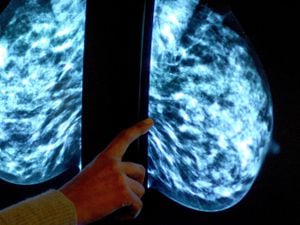Immune cell discovery ‘could lead to personalised treatment for breast cancer’
Researchers identified features of immune B cells which make them successful at targeting tumours.

Scientists have found that some immune cells hunt down cancer in the body, a discovery that could lead to personalised treatments for advanced breast cancer.
The study identified features of cells called immune B cells which make them successful at targeting tumours, including when cancer has spread to a different part of the body.
Researchers have developed a tool to identify these anti-cancer cells which could lead to improved, personalised immunotherapies, they say.
Immunotherapy uses someone’s own immune system to fight cancer, and works by helping the immune system recognise and attack cancer cells.
Dr Stephen-John Sammut, first author on the study and leader of the Cancer Dynamics Group at The Institute of Cancer Research, London, (ICR) said: “Once cancer spreads to other parts of the body, it’s often much more difficult to treat.
“Our research has revealed that the immune response to cancer isn’t limited to the site where a tumour initially appears – if an immune B cell is successful at detecting cancer in one part of the body, it will search for similar cancer cells elsewhere in the body.”
The consultant medical oncologist at The Royal Marsden NHS Foundation Trust, added: “Currently there are very few immunotherapies that can be used to treat breast cancer.
“The computational tool we have developed will allow us to zoom in and identify the B cells that have recognised cancer cells, as well as the antibodies they are producing.
“This will allow us to develop anti-cancer antibody treatments similar to the ones the B cells produce, which can then be given as a personalised treatment to boost the immune system’s response against breast cancer that has spread.”
Scientists at the ICR, the University of Oxford and University of Cambridge, took biopsies from patients with breast cancer and identified genetic variations in the B cells.
B cells are part of the immune system and produce proteins called antibodies which stick to harmful substances such as viruses and cancer, and recruit other parts of the immune system to destroy them.
The team studied the B cells of people with advanced breast cancer who had died, after their cancer had spread to other parts of the body.
They also looked at a group of patients with early breast cancer, as they were treated with chemotherapy over time.
According to the study, when a receptor on the B cell identifies a cancer cell and binds to it, the B cell changes to be even more effective at targeting those cancer cells.
Some unique B cells which had changed – after identifying and targeting cancer cells – were present at multiple tumour sites the cancer had spread to, the researchers found.
This means that recognising cancer in one area of the body, B cells hunt down cancer at different sites around the body.
Other B cells which were found only in one tumour site were less likely to have changed and did not perform effective cancer surveillance.
The researchers used this information to develop a tool to predict which B cells were most likely to successfully detect and target cancer cells.
Professor Kristian Helin, chief executive of the ICR, said: “Immunotherapies have transformed the outlook for a range of different cancers but, unfortunately, they still only work for a minority of patients.
“We need a greater understanding of how the immune system defends the body against cancer and most research has, until now, focused on the role of T cells – with CAR-T cell therapy being the best-known treatment to come from that research.
“This study provides a fascinating insight into the role of B cells over the course of a cancer’s growth and spread, and I look forward to seeing this tool used to focus efforts for the development of personalised cancer immunotherapies which could work in far more people than most existing immunotherapies.”
The findings are published in Nature Immunology.





